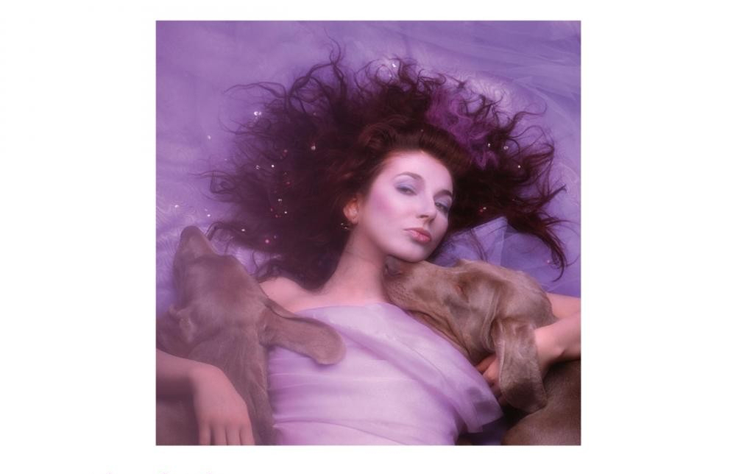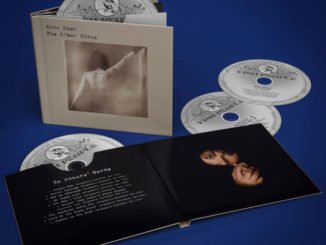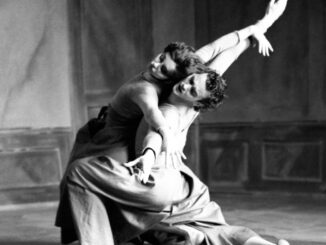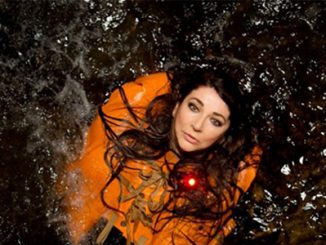
September 2020 marks the 35th anniversary of the release of Kate Bush’s seminal album Hounds of Love. The album has been cited by numerous musical publications and artists as a trailblazing and influential work that had echoed throughout many artists’ creations over the past 31 years. Many have tried to imitate the album in sound and themes but none have surpassed the brilliance of Bush’s glorious work.
Kate at the young age of 22 had already recorded four albums with Hounds of Love being the follow up to her 1982 release The Dreaming. The Dreaming was the first time Bush had been in complete control in the sound booth as a producer. The success of her debut album The Kick Inside won her significant creative independence and patience from her record label a rarity in this period of popular music. From the beginning of her career, Kate was known as a renegade who did not play by the usual record industry rules.
A topic that is not often discussed when looking at Kate’s accomplishments was her ability to create a way to use the corrupting music label industry for her own devices. That skill alone is enough to make her a legend. Her musical abilities and risk-taking in her music make her a trailblazer. Very early in her fledgeling career, she realized the importance of artistic control. She set up her own publishing company and management after her disappointment in her treatment by the marketing at EMI and additionally being rushed by the label to record Lionheart. She always felt that Lionheart had not turned out as good as she would have liked. Her success on the charts would enable her to demand more time to record and enable her to release music only when it met her high standards.
In 1978 Kate was all of 19 when she topped the UK charts with Wuthering Heights off of The Kick Inside becoming the first female to achieve a UK #1 with a self-written song. As she moved through her various releases she looked to pushing the envelope and attaining artistic perfection. She quickly became know for her amazing vocal range, exquisite stylings and need to control and make perfect all her recording efforts. EMI was relatively undemanding about Kate’s work and level of success until the aftermath of The Dreaming. The Dreaming was ambitiously unlike Kate’s prior works and did not have a recognizable hit single. The album did not perform commercially as well as her prior efforts and the label put pressure on Bush to knock the next release out of the park. It was not for lack of effort that The Dreaming failed to find an audience; unfortunately, the surreal sonics and themes did not make for easy listening. Bush was exhausted after touring for The Dreaming. She decided after three years of unrelenting work to take a break. With the decision, she found her self in unmoored territory and was confused and disoriented by not to have do promotional work or perform studio duties. She also experienced writer’s block for a period of about five months. Bush described this period as such, “It’s very difficult when you’ve been working for years doing one album after another. You need fresh things to simulate you. That’s why I decided to take a bit of the summer off and spend time with my boyfriend and with family and friends, just relaxing. Nor being Kate Bush the singer, just being myself.” In the summer of 83, she built a 48 track studio in the barn behind her newly purchased farmhouse. This event energized and inspired Bush to begin what would become Hounds of Love.
In January of 1984 Kate in her home studio at Wickham farm, Welling, England she began recording demos and enhancing them rather than re-recording them. Five months into the work she began overdubbing and mixing the album. The entire process took a year. Musically the album would be a marriage of traditional world instruments and utterly futuristic machinery, particularly the Fairlight synthesizer, which was the 80’s version of today’s Pro Tools. Always looking to expand her sonic palette she utilized everything out there that was available and a few things only she seemed to know existed. In the studio, Kate performed alchemy blending literary influences and a definite storyline especially on side two of the album. Throughout “Hounds of Love” would be loaded with Kate’s trademark melodramatic emotionalism and surreal musicality. The result was not only a winning release but a masterwork. “Hounds of Love” would be Bush’s 2nd chart-topper in the UK and her best selling studio album to date. It would go double platinum and by 1998 sell 1.1 million worldwide and actually make it across the pond reaching the top 40 on the Billboard 200. The singles are all taken from the first side of the album and were; Running up that Hill, Cloudbursting, Hounds of Love and The Big Sky. It was the great success that Kate achieved that finally brought her to the attention of a larger American audience. As per usual American exposure to a seminal British artist was a day late and a dollar short but led to a significant following of dedicated new fans on the US side of the pond.
There is an inherent dichotomy to “Hounds of Love” and it has a definite split personality. Kate fully utilized the format of two sides on a recording. The first side is the most approachable yet contains numerous deep and esoteric themes. That side presented everything anyone familiar with Kate’s prior work had come to expect. It examined many Freudian themes, the relationships of parents and their children, anxiety, Eros, ecstasy and nature. Throughout there is a total emotional commitment from Bush that is physically palpable. The second side would be more ambitious and more difficult for the indifferent less adventurous listener to grasp. The second side or as it is titled, The Ninth Wave is beyond almost anything attempted at the time. It was a concept album to the nth degree, cohesive and evocative as it dealt with death and the unimaginable. Where the first side was life and Eros The Ninth Wave is Thanatos and facing imminent death; the loss of control. The Ninth Wave is extraordinary, mystic and ultimately epic.
The album kicks off with fireworks, Running up that Hill (a Deal with God), is stunning. The song at its heart expresses the desire to trade places in a sexual experience with a lover in order to know the sensations the other person is feeling. It expressed the craving for a full 360 view of the experience, “…and if I only could, I’d make a deal with God and I’d get him to swap our places…let’s exchange the experience.” The song could also be taken on a non-sexual level as anyone wanting to switch places with someone else. The selection is suspense-laden with the intro and produces a physical impact as Bush allows her vocal to deliver the climax of ecstasy. It is sensual, yearning and bittersweet as it ensnared the listener and would portent the intensity that would exist throughout the album until the final note of the last track.
Hounds of Love would be just as dramatic as Running up that Hill with the ominous opening,” It’s in the trees it’s coming.” The song expressed one of Bush’s recurring lyrical themes; the terror of being trapped by love. Here she portrays it as a thing of nightmares. She portrays herself as the fox hunted by hounds of love but instead of the kill there is surrounding by love, “Among our hounds of love, and feel your arms surround me. I’ve always been a coward, and never know what is good for me.” The end result of this hunt is the recognition that accepting love makes each person better. The song married mythic themes with modern concerns. The building ethereal atmosphere created by the Fairlight synth makes for a mental diorama where you could visualize the internal battle taking place. Bush’s vocal delivery is explosive, climatic and bombastic and serves the piece perfectly.
The Big Sky is a glorious display of Kate’s wide-eyed adoration of nature. The theme is all-encompassing nature and that everything pales in importance beside the beauty and rhythm of nature, “You want my reply? What was the question? I was looking at the big sky.” The song is in many ways is an emotional cousin of Wuthering Heights” and Kate uses all her vocal abilities to sell the romance and transcendence of the song. She is also a genius in her combination of distinct beats with blended synths to produce a winning track.
Mother Stands for Comfort is a favourite track for me. It is very Freudian in theme. The song thematically delves into mother /child relationships, displaying the love bond that gets stretched but never breaks. Mother is the judge and jury but never the executioner. The track examines the inherent love/hate relationship that makes for the complexity of child/parent interaction. In the intro, there is a glorious build from the crashing of something as a young child gets in trouble and progresses with the child’s development and the mother looking the other way as more serious errors and accidents take place, “Mother stands for comfort, mother will hide the murderer, mother hides the madman.” The sparse percussion, wonky Fairlight and piano keyboards perfectly reflect the complexity discussed in the lyrics. The lazy bass and whistles provide tension as Bush dives and swoops vocally. The song is simply sublime. I also love the twist in the last lyric “Mother will stay mum.” It is brilliant because it can be read two ways; she stays silent about the wrongs committed or stays your mum no matter what you do.
Cloudbusting was inspired by “A Book of Dreams”, by Peter Reich about his father Wilhelm Reich an Austrian-American psychoanalyst who developed a cloudbuster machine he claimed would make rain. He was jailed by US authorities because of his controversial experiments. Rather than try and explain his bizarre practices Bush focused on the relationship between father and son. The underlying idea being that no matter how strange our parents we love them. It is a touching song and a moving look at a child trying to save a parent from forces that will destroy the parent, “I can’t hide you from the government, Oh God, Daddy I won’t forget.” The instrumentation in the song builds the tension as Bush’s vocals float over the building ascent to the climax and galloping drums beat a tattoo. The train sound effects at the close suggest the child’s move to adulthood and cap off the last lyrics, “The sun’s coming out. Your son’s coming out.” It is another spectacular selection.
The second side begins; Bush entitled it The Ninth Wave taking the name from Tennyson’s poem, “Idylls of the King.” The poem was about the legendary King Arthur’s reign. This side is meant to be listened to in its entirety. “The Ninth Wave” recounts the tale of a girl cast adrift in the ocean at night following an undefined disaster. She awaits rescue encountering the excruciating uncertainty of whether she will survive till morning. She is trapped in her own head at points wishing to succumb and hallucinating. She watches her life flash before her and imagines various things going on as she all but gives up at different points in the harrowing experience. The found sounds and overdubs throughout the songs lend guideposts to the listener as the side unreels.
And Dream of Sheep starts with a gentle piano intro. The narrator is lost at sea and struggling to survive armed with only a lifejacket and a little survival flashlight in the desperately cold North Atlantic. She listens for any sign of rescue, imaging rescue ship engine sounds and gulls signalling rescue rafts, “little light shining, little light will guide them to me.” Meanwhile, the beautiful guitar and whistle effects reflect the already present temptation to fall asleep and drift away on hypnotic hypothermia liken to poppies and give up the struggle, “Let me be weak, let me sleep and dream of sheep.”
Bush presents the narrator slipping away and being jarred out of her dangerous hypnosis by Under Ice. The strident strings reflect a skating effect paralleling an image of the narrator getting closer to death both figuratively in the skating on thin ice image and literally with the danger of drowning at sea. In both settings drowning or freezing to death trapped under the ice are the ultimate threats. Succumbing to the waves or falling through the ice will bring the same result. There is a feeling of total abandonment and desolation as Bush provides icy vocals over the fitting accompaniment. The end of the song is almost like the narrator willing herself awake. She realizing the situation is dire with no certain rescue and only she can save herself at this point by remaining above the waves.
Wake the Witch has always felt to me like a hallucinogenic vivid dream the narrator is having as exhaustion and fear start to win the battle over survival instincts. Here the girl is almost driven mad by what she is encountering. The conflict is both external with the cold sea looking to claim her and an internal conflict in her fight against her inner voice telling her to surrender. The demand she gives in is personified by the demonic preacher’s voice. The song starts delightfully with various familiar people awakening the girl then shifts into something darker. The song is also cast in parallel with the Salem Witch Trials, with that struggle against hysteria and evil likened to the narrator’s struggle for sanity and calm in an unthinkable situation. I often think of this song as the point where the narrator looks death full in the face. The track can be fairly disturbing but that is the point. The situation is completely harrowing and excruciating. The nightmarish quality of the accompaniment conveys all the uneasy and panic the girl is feeling as she has reached the crossroads in her ultimate life or death struggle. The sudden explosive cacophony and keeling for help in the outré displays the frantic fear that has enveloped the girl.
Watching You Without Me seems to present the narrator at her lowest nadir, she seems to have come to the conclusion she will not make it, she is accepting and surrendering. Presented is a scenario where she is invisibly visiting the home she lives in and sees her lover but can not talk to him to wish him goodbye. Kate is singing the selection as if with the blue numb lips of the heroine as she desires to say farewell before her last moments expire. “Can’t let you know what is happening. There’s a ghost in our home, just watching you without me.” The song is heart-rendering and beautiful. It conveys equal parts acceptance and overwhelming sadness. The Indian influenced mantra section is prayer-like. The song then enters into the jumbled vocal that looks to portray the short-circuiting of the brain before death. The syncopated rhythm of the accompaniment serves as a ticking clock and dripping water.
Just when all hope is gone, Jig of Life launches. It is like a jolt of electricity that jump-starts the resolve of the girl. It serves to give hope to our heroine helping her to struggle on. She is visited by her older self stridently telling her she can not give up and her life belongs not to her but to the older self, “ this moment in time, (she said,). It doesn’t belong to you.” (She said,) it belongs to me, and to your little boy and to your little girl.” The old lady is stating that surrender is not her choice. It is a rousing section that I have always interpreted as the final summoning of strength and leads to the beautiful poem read by Kate’s brother, John Carder Bush. The instrumentation is filled with traditional Irish instruments and injects a surge of energy into the track. The lyrics also stick with you long after listening to the song. The sudden abrupt ending to the tune ushers in Hello Earth.
This is my favourite song on the album. Hello Earth can be interpreted so many different ways. The most common is the out of body “Overview effect,” which is a very real psychological effect and cognitive shift experienced by astronauts and cosmonauts. It is the awed feeling of ultimate compassion and understanding of the fragility of our planet. “With just one handheld up high, I can block you out, out of sight, peek a boo, peek a boo little Earth”. The song needs to be taken from the perspective of the narrator having an out of body experience. The sense of displacement is palpable. The narrator is on a low trickle charge and life had all but extinguished. She is transported to the past, present and future. The past the lyrics about driving home, “I can be driving home, with you asleep on the seat, I get out of my car, step into the night and look up at the sky.” The present, “watching storms start to form over America, can’t do anything just watch them swing with the wind out to sea.” Finally the future, “I was there at the birth, Out of the cloudburst, the heart of the tempest, murderer! Murderer of calm.” The transitions are assisted by the Russian Gregorian chant from the Kakhetian region called “Tsiniskaro” which provides the interstellar feel. None of these time segments is concrete but liquid as they roll into each other. I also think there is a spectacular coincidence in the occurrence of two themes from the first side, Cloudburst from “Cloudbursting” and murderer reference from “Mother Stands for Comfort”. The selection is the longest on the album and displays the wonder of human existence through Bush’s gorgeous vocal, which is sweeping, dramatic and evocative. The last lyric “Go to sleep little Earth” leaves the listener wondering if that is the end of our heroine.
Hello Earth bleeds into The Morning Fog. There has been some disagreement among fans as to whether the narrator survives. The question is whether this is a praise song upon rescue or does the narrator perish and this is a song of rebirth? I lean toward survival and Kate Bush has stated the narrator survives and not to take the lyric, “being born again” literally but figuratively. My conclusion is that the heroine after her harrowing experience has acquired a treasure trove of wisdom and is completely changed i.e. reborn. The song conveys a completely different feeling: the fear, threat, anxiety and madness have given way to ecstasy and joy. This is mirrored by the chimes and sheer beauty of the accompaniment. We and the narrator have travelled through this harrowing ordeal and she has survived. It is an understatement to say the Ninth Wave is completely enveloping and emotionally cathartic.
Hounds of Love delivered a masterpiece for Kate Bush and would guarantee artistic independence for her now long career. This exquisite, idiosyncratic album would pave the way for many female artists to follow. She would singlehandedly create the personage of the enchanting songstress that Bjork, Florence Welsh, Natasha Khan and Catherine Davies to name just a few would emulate. Bush would with “Hounds of Love” deservingly win at the 1986 Brit Awards, Best Album, Best Producer, Best Female Artist and Best Single for Running Up That Hill. Her vision and determination along with her breathtaking musical abilities make her a living legend. The songs off of “Hounds of Love” have had such an enduring potency that 29 years later Bush would return to live performance to present Before the Dawn. Bush would perform all of the songs from Hounds of Love except The Big Sky and Mother Stands for Comfort in front of sell-out crowds. Before the Dawn would dramatically flesh out visually the story of The Ninth Wave. As this retro review goes to press Bush has announced the live recorded release of the Before the Dawn performance. In the end “Hounds of Love” is a masterwork because it is still as fresh and engaging as the first day it was released. Hounds of Love has an unfathomable emotion impact on listeners with a beauty that is breathtaking. It is a true example of an essential album and listening experience.





Be the first to comment